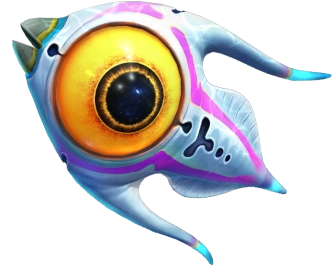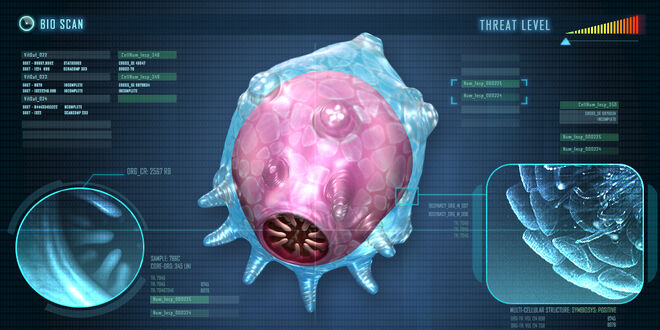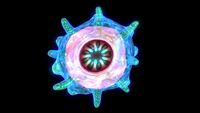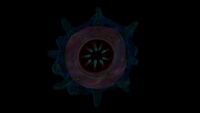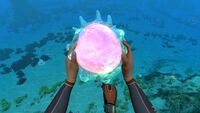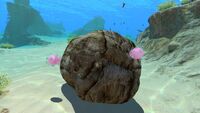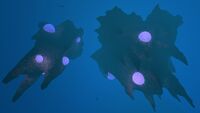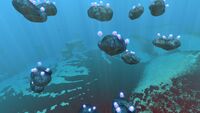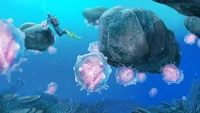Floaters are a passive, interactive fauna species found in Safe Shallows and Grassy Plateaus. They can be caught and can be attached to items and props, but not all of them will provide buoyancy after attachment. There are two types of Floaters: small and ancient. The small Floaters can be held in the players hands, and can be attached to items. Ancient Floaters, on the other hand, are found underneath the Floating Island and Underwater Islands. They are huge relatives of the small, portable Floaters, and hold up the latter and the former. Ancient Floaters are noninteractive and are flatter than their smaller kin.
Floaters can be used to move rocks that occasionally block cave entrances.
In Creative Mode, the Player will spawn with five Floaters in their inventory.
They will at times attempt to attach themselves to the player. This will result in the player's 10% health loss and the Floater's death.
Appearance
Floaters distinguish themselves by their transparent, gelatinous, blue-colored surface and a pink core, or body. The floater will expand and contract when attached to an object. The life forms have strange bumps on their blue masses with five small, white circles in the center. They have multiple small tentacle-like arms near a mouth with which they attach themselves to objects. The mouth has small teeth inside.
Behavior
Floaters are usually found attached to rocks, rendering them buoyant.
If released in open water, they will quickly float to the surface.
If released close to another creature, the Floater will home in on the creature and attach itself to it, making the creature partly or completely immobile and dragging it towards the surface. In some cases, this will kill the creature. For other instances, with large creatures, like Reefbacks, the Floaters will greatly hinder the latter's movements.
Hazards to Vehicles
Despite their small size, the Floater's ability to stick to any surface and its high buoyancy makes it a trouble for both the Seamoth and the Cyclops.
Touching a Floater with the Seamoth will make it attach to it.
A single Floater attached to a Cyclops can tilt it to the point of complete loss of control of the vehicle.
Although they are mostly considered as hazards, it can be considered a last resort to attach Floaters to a sinking Cyclops to prevent it drop sinking past crush depth, so you can repair and save it. The Floaters will have to be removed after repairing the Cyclops, in order to use it again.
Energy Value
Data Bank Entry
|
Two species living in symbiosis, which attach to and attempt to feed on any objects they come into contact with. 1. Dominant Lifeform: 2. Microorganism Membrane: 3. Helium Buffer: Assessment: May aid in flotation of sunken objects |
|
Biodata suggests these vast floaters have matured in an ingenious symbiosis with the land they have attached to. - The attached landmass is raised in the water, increasing sunlight and encouraging plantgrowth Lifecycle: In extreme circumstances a number of floaters may attach to a leviathan class lifeform, forcing it to the surface and effectively asphyxiating it. The body will be consumed over a number of months until eventually dissolving, leaving the floaters free to attach to a new host. Those creatures which successfully raise a landmass to the surface are rewarded with a burgeoning and permanent food supply, allowing them finally to reproduce and begin the cycle again. Assessment: Incredible |
Gallery
Trivia
- Despite being one of the most peaceful lifeforms in the game, the Floater is also one of the most destructive, as it can cause the player to lose their Seamoth and Cyclops, and even destroy them.
- Floaters are currently the only lifeform in the game the player holds with two hands.
- Floaters may be based off a real-life deep sea creature named "pyrosomes" which share a similar appearance to Floaters and are also made up of a colony of creatures. They also can grow to large sizes, just like Ancient Floaters.
- If the player uses a Habitat Builder to build a compartment that is partially inside an Ancient Floater, the Ancient Floater will disappear, though the Underwater Islands and/or the Floating Island will still float even if all the Ancient Floaters disappeared.
| Fauna living within the Crater | |
|---|---|
| Carnivores | |
| Herbivores | |
| Scavengers & Parasites | |
| Leviathans | |
| Extinct | |
| Other Entities | |
